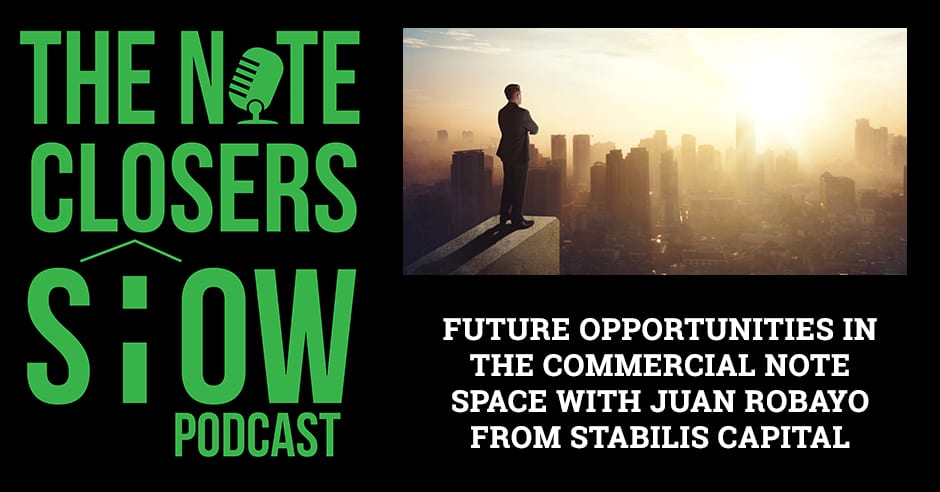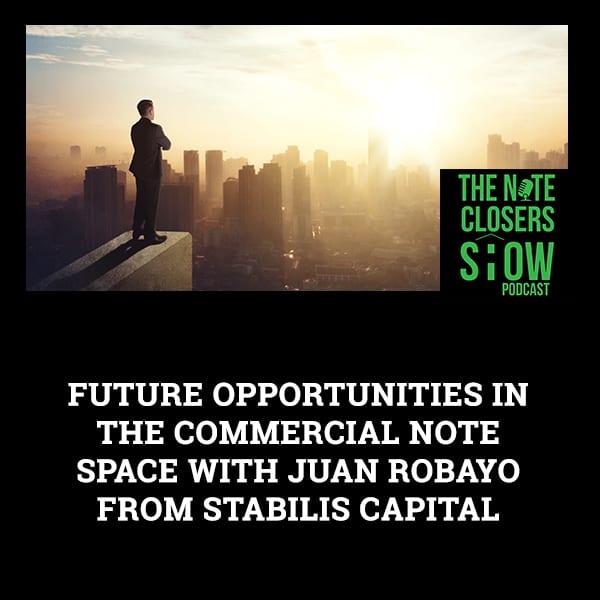
It is no doubt that the real estate sector got hit badly by this pandemic. With it comes a lot of distressed assets. If you are looking to pivot or tap into this space, then now is the time to do it. In this episode, Scott Carson talks with Juan Robayo from Stabilis Capital about future opportunities in the commercial real estate and debt space. Juan shares the different asset classes they like in terms of how they operate or originate loans and reveals effective strategies for financing and raising money. Taking us to what they do, he then discusses their note financing program and how they are helping investors take on the opportunities that come their way.
—
Watch the episode here
Listen to the podcast here
Future Opportunities In The Commercial Note Space With Juan Robayo From Stabilis Capital
I’m excited for our special guest. We all get hit with so many different emails and advertisements that are going on in the industry. I probably get more than most people do because we are in both the residential and the commercial space. Every once in a while, I get something that makes me have to go, “Let me look at that again.” I was excited to get an email from a company. I was talking about bridge financing and commercial loans. One thing caught my attention. It was the financing of note purchases.
We’re honored to have a star from the Stabilis team. Everybody, we’ve got Juan Robayo. This guy has many years of experience in the financial sector team. Prior to joining the Stabilis team, he was the Director of the Fixed Income Group at Barclays and Lehman for seven years. Prior to that, he worked with Stabilis’ CEO at Goldman Sachs and Silver Point Capital in the US middle market loan acquisition business. This guy got a wealth of experience in the distressed asset space. We had a great conversation. I’m honored to have him as a guest on the show. Juan, welcome to the show.
Thank you so much for the invite, Scott. I’m happy to be here. I’m happy to share, interchange comments and ideas of what’s going on in the markets at these very challenging and interesting times.
Let’s talk about what Stabilis is doing and what you guys are doing over there, first and foremost, and then we can dive into some of the different products and the asset classes that you guys are financing.
To frame the conversation, let me give you a background of who we are what we were doing. Salman Khan started it in 2010. I joined three years later. We’ve raised $1.7 billion since the inception. We’re on our fund five. Fund five was around $550 million in equity. We have around $200 million to invest between 2021 and 2022, when we’re going to be raising capital again. We started in the aftermath of the Great Recession. We started buying nonperforming notes from the banks. The banks had a lot of problems. They were cleaning up their balance sheet. We were a small player on a huge trade that was buying nonperforming notes from the banks. We invested a lot of money there during the initial funds. That’s our background. That was what we did in Goldman Sachs and Silver Point Capital before.
Was that more so on residential or commercial stuff?
Everything is commercial. We cannot do resi. We can do resi on a portfolio basis, but our mandate is not on the resi side. It’s only on commercials. About years ago, as part of adjusting to the market dynamics, the economy was doing well. The banks cleaned up all the balance sheets to distress and the distressed theme, in a way, disappeared. We saw a niche that a lot of players and similar companies to us saw this opportunity to invest in the private lending space. We created an origination program. We increased the number of sources dedicated to cover brokers and in these types of situations. We started covering the market. We started doing more bridge than note purchases, the ones we’re not selling, but we’re still active on the note purchasing space. We still have a loan relation with banks and sellers. We still see that.
Everything is going to change. We were very active in terms of the bridge program. We are very focused on cashflowing properties. Before COVID, we were very active in hotels, which is a very complex cashflowing property because it’s not only a real estate, but it’s also the operation on top of that that you need from a credit perspective understand both. We were big in hotels, healthcare, offices and what we call Special Situations. We did a power plant, industrial spaces in Canada, operations in a couple of transactions of industrial properties in Ireland and Puerto Rico, but 95% were booked in the US by looking at different situations, trying to be creative and adding value to the loan origination business. Fast forward, COVID happened. We took a breather and tried to understand what’s going to happen.
First, we have the reference of our book. What we saw in our book is, for instance, hotels that we had ready for sale. We saw on our hotels in general, across the board, 20% to 30% correction on good hotels. Who knows what the value correction is going to be on hotels that are not viable anymore? It’s probably more than that. In hotels, the idea is we’re going to be very selective. It takes us to the note-on-note financing and a couple of different transactions that we’ve done. That’s one of the things. We see the multifamily is still very strong. It varies. I know your multifamily is different than other places or some are probably closer to San Francisco. Generally, it’s very different. Multifamily is solid as a class. We see opportunities there.
We see the consequences of the distressed market or recession market. We see maturities coming up and acquisition opportunities. We’re trying to play and provide financing on those. Industrial is a very strong asset class, especially with logistics needs. We also did a couple of industrial transactions in Phoenix and Chicago during COVID. I’m still looking for those. It’s very negative on retail. This season is going to be a big test. Let’s see how December 2021 plays out in terms of closures in business and social distancing. We see that it’s going to be the biggest transaction in terms of buying all the presents from the internet and not going out. We are very negative on retail. These are general trends. We do see it in a case-by-case scenario.
We were negative on the suburban office. The suburban office is getting somehow a peak up because people are moving back to the suburbs, but still, dynamics are not that strong. Cities are going to make sense, but you’re going to have a lot of supply, reconfiguration and re-adjustments, especially in large cities and markets. That is going to take a while. We’ve seen the biggest impacts. San Francisco is one of those, also Chicago and New York. You have different impacts to a lesser extent on other metro areas.
Healthcare is an asset class that we like. We like to work with operators that are facing maturities or the opportunity to refi, but healthcare is a complex asset class. You need to have licensing issues. We’ve done a couple of relatively large transactions that we exited during COVID, a $50 million transaction so-and-so. It’s not for everyone. We feel that there is an opportunity. We are actively pursuing that. In all the other asset classes, we did a couple of franchises. We liked the franchise. I also saw some franchises have shown strong performance. Some are not so much.
Casual dining is a challenging space, but the transactions that we did around the casual dining space. We did it in two forms. One, during a bankruptcy scenario. We’re very comfortable with bankruptcy, bankruptcy negotiations and the process that it entails. It requires legal knowledge. We’ve done it so many times. We started doing a lot more DIPs this 2021. We lost one to a retail operation. We lost it because the competition got aggressive in pricing. DIP in bankruptcy is also somehow a limited market, but it’s very active in bankruptcies in restaurants. We’ll see there what the franchise and the future of those are. We’re providing liquidity and helping situations in the restaurant.

Commercial Note Opportunities: You need to make sure that the new note holder is going to be able to operate the asset and has the ability to do it because they’re putting equity on it.
Those are the general asset classes that we like in terms of how we operate or originate our loans. We’re very focused on cashflowing assets. We can lend up to 75% LTV. We provide liquidity on acquisitions, maturing, debt restructuring and bankruptcies. Our starting rate is 8% and then some points. We’ve done lower, but then we compensated on our end. The way that we want to see our deals is by providing liquidity through a stabilization situation. Relatively, a short-term loan is 1 year with 2 to 6 months extensions, where we see the light at the end of the tunnel.
The other asset, which is a combination of both, the note purchase and the origination business, and there’s one transaction that we deemed and seen a lot, but it’s a note-on-note purchase. We had a situation in which there was a debt that’s about to mature. Somebody bought it. The original lender needed to sell the note for risk or liquidity issues. They started a sum of discounts in the original collateral. We got comfortable working with the group on getting a value that they were lending. They know that they bought it.
There was about 75% LTV. We were comfortable financing about 75% of the acquisition. From our perspective, we are 50% LTV. We’re providing liquidity to the buyer and we can work with them on the worst-case scenario if that materializes. From a risk perspective, we are facilitating. We understand the asset class. We have somebody who is willing to operate and capable of operating the asset if anything happened. Those are the key considerations that we’re going to be looking at on the note-on-note financing.
You’re taking a step back from getting to the asset. You need to make sure that the new note holder is going to be able to operate the asset and has the ability to do it because they’re putting equity on it. On top of that, we have the equity of the original assets. We’re trying to be protective and conservative. In general, our approach post-COVID is some liquidity dried up. Some funds like ours similar in size got some loan pool. We were comfortable with our strategy and executing the strategy. We took advantage of some situations, which some other funds were not able to deliver.
At the end of the day, we are conscious that whatever happened during this period is how we’re going to be judged in the future when we raise more capital and how we interact with clients as well. We cannot be issuing and committing to things, which I’ve seen, committing to a lot of loans that some funds are not able to execute. We’re very careful in what we execute and we’re being selective. In general, I’m optimistic about what the economy is going to bring, but our sector got hit badly during all these times. We’ll see.
There’s going to be a lot of needs, but the economy is strong. The consumer has been strong. The stimulus works fine. We’re going to have another round. We’ll see what the size of the stimulus is. It’s to give support to the American consumer, which is the main component of the GDP and then give time to everybody to catch up later. In real estate, it’s harder to catch up. If you own a hotel and you didn’t have any revenues for a year, you’re behind and it’s hard to catch up. There’s going to be a correction. It’s the same thing on rents and multifamily. It’s hard to know exactly what that effect is going to be now, but we’re going to see it when we start. We’re executing and providing liquidity on relatively conservative terms but to properties and situations that we believe fit our profile.
Let’s dive in about multifamily. We were talking about that. You have your traditional multifamily, but you also have a lot of student housing. I think that’s probably been hit harder than your traditional multifamily. Are you seeing some of that student housing stuff floating across your desk? Are people reaching out to financing stuff?
We like student housing, but we like some under certain criteria. First of all, we don’t do a smaller college or student housing for less than 10,000 or 20,000 students. On the ones that we like, we’ve seen a lot of distress, but on the big campuses, it’s a good opportunity. We’re actively looking at that. Multifamily, in general, is a very strong asset class that bonds interestingly enough. If you think about what happened in 2008, we started seeing a lot of flow from the banks a year and a half after the main event in September 2008. The banks were in a totally different position than they are now.
What we expect and what we’ve seen is, first of all, banks have not been selling COVID-related assets. The ones that we’ve seen are part of the regular process of risk management. They’ve been active in it and the other ones are coming to the market. On the COVID-related assets, the only big transactions or trades out there have been on hotel portfolios. Banks are being more productive than others because the regulators have been patient and the banks are in much better shape. You don’t need to push banks to start selling as if they are somehow. We’re going to see it and that is going to change. I expect that defaults are going to happen. They need to start marking and these are carrying costs for the banks to have these assets. I expect that to happen, but so far, it hasn’t happened yet. It’s similar in 2008. It takes some time. Now, the banks are in a better position than they were in 2008.
Specifically, when you look at the amount of money that’s being saved right now, that’s on deposits with them. The greatest amount of deposits and savings that we’ve seen in decades are helping them with their reserves and holding the money back to trickle down or kick the can down the road a few months to figure out where everything is at.
A lot of the savings is also coming from the consumer because the stimulus is a good public policy to support the consumer. The saving rate of the consumer is at an all-time high, but banks, when they see defaults and when their forbearance starts expiring, the rules are not going to change. They’re going to start marking. When is that going to happen? The damage to the real estate is done. There are hotels that were not able to support and are not going to be able to support the debt. That asset needs to be either restructured, sold or DPO it to the borrower in some way and there’s going to be a repricing of that.
Going back to your original question, on multifamily, we haven’t seen much. Banks, in general, I haven’t seen much. For COVID-related, I expect that to happen. Banks are in good shape to face all these crises. Also, there is some memory of the crisis. It’s not too far. For instance, it’s far for people who enter the industry, but still, a lot of people have been through this, especially on the bank side. The challenge is going to be for the banks to have the special asset groups re-assemble again and then start working. Some of these special asset groups are just a couple of people because there was no need, but the institutional memory is there. The banks are in better shape. Also, there is a lot of capital.
Here, we’re not feeling anything close to the panic in the liquidity panic that we felt. Every crisis is different and this crisis is different in that sense. I don’t see the financial market at risk now. We see a ton of capital also has been raised on the big funds for distress opportunity. That is going to be allocated. That’s one of the things I look at the transaction that I mentioned on a bankruptcy’s complex pricing. People were willing to put relatively low yields because there is liquidity and there are some views. People are taking a longer-view approach to the recovery and some of the opportunities. Liquidity is there. A lot of smart capital has been raised and we’ll see how it pans out.

Commercial Note Opportunities: At the end of the day, we are conscious that whatever happened during this period is how we’re going to be judged in the future when we raise more capital and how we interact with clients as well.
For those investors out there who are looking to pivot or tap into the distressed asset space, you mentioned there’s a lot of money out there that’s been pulled off the sidelines from a lot of funds, waiting for some of the opportunities. What kind of values do you think a normal investor who’s looking to tap into some of the stuff should be looking at and evaluate? Are we talking $5 million or $2 million and below? Can you give any insight into what you’re seeing and where you think the opportunities are aligned?
In terms of size, it’s hard to tell. On the hotel side, we saw a lot of hotel financing. Places like New York, San Francisco and Chicago are relative to $20 million to $300 million, $400 million. There’s going to be a lot of that. The CMBS market absorbs a lot of these risks. That’s another part that we’ll see an opportunity because the CMBS market is probably at half of what it used to originate. 2022 is going to be half of 2021 until it recovers. It’s going to take time. The need for capital, we expect it’s going to come to guys like us at any size. There are going to be the needs at the $5 million to $50 million asset class. That’s where our focus is. It’s going to be capital needs on $50 million and above somebody else, because the capital is there and it’s ready to be required. The CMBS is not going to be able to absorb. There are going to be maturities and restructurings that are going to be done. In terms of size, it’s hard to tell, but I think we’re going to see everything.
Have you seen anything already on people pivoting hotel or office space into something that makes more sense, where they’re pivoting from office to self-storage or trying to turn hotels into apartments or short-term housing to get through the downturn?
Yes. The main theme is a lot of the hotels in the cities are not going to be viable for some period of time in the near term. Also, there was an oversupply and over-construction because of hotels. Both of these are going to make it. We’re seeing it on some of our assets. There are a lot of people who are bidding not to operate as a hotel but to try it into multifamily. What is the cost associated with it? What is the operation associated with it? It’s not going to be a hotel anymore. That the main change of use on that. On the industrial side, there’s a big demand. Anything that you can reposition. Also, build to suit the industrial and demand are not our game.
I’ve seen a lot of construction loans maturing on hotels, but the hotels don’t have any operational history. I’ve seen the true bets. I’ll say, “What was the cost to build this hotel? I’m buying it for a fraction, but what is the future of this? Is this a need for this hotel or not?” There’s a strong need or a lot of demand and then you have to go asset by asset. People are saying, “On that, maybe without operational history, I’m buying it at a big discount. This hotel has a reason to exist,” then they continue operating. People are saying, “This is not going to be a hotel anymore. How much does it cost to turn it into multifamily and take the different pricing on that?”
It depends on the saturation of that asset where it’s located. I only brought it up because I live on the Northside of Austin. Within 1/2 mile of where I live, there are probably a dozen smaller hotels like the Candlewood Suites or the Courtyard by Marriott, 100 hotel rooms or less. Several of them are brand-new built that have not operated at all. They’re completely still vacant. They’re done, but they still got gates up and not doing anything. It’s interesting to see it because they still have the finance by Compass bank out in front. That’s an opportunity, especially on our side of town. There’s a big need for affordable housing. That’s why the transition makes a lot of sense.
That is on every market. It’s the same thing with New York. We had a ton of supply of hotels that they don’t have a reason to exist and then you’re going to have a bigger pressure on rents. That in many other places in the near future. The multifamily underwriting is a whole other challenge, but then you have, “What are the needs? What are the markets?” as you were saying in Austin. There are stronger markets. A lot of people are also thinking about sellouts and condo sales. Then you have low rates that are in favor. There are a lot of products that are eventually going to be absorbed. It’s going to be a matter of pricing, but it’s going to be people selling it.
You mentioned financing up to 75% of the acquisition price for the value of the loan when you’re doing the loan stuff. On your traditional brick and mortar, is your actual funding on an asset versus a note sale the same percentage? Do you guys look at a different aspect of LTV and debt coverage ratios?
If I use the transaction that we did as an example, the collateral value is the collateral value. We both agreed on that ballpark amount. We want it to be on a note-on-note. Since it adds complexity, we want to be on a lower level versus the collateral value. We are at 75% of the note amount. By doing that 75% eventually, we’re more protected on our 50% LTV. We don’t want to finance 100% LTV notes. We’re not going to provide liquidity of those. We want to provide liquidity to notes that we would have underwritten at 75% LTV. By doing 75% of that, we’re naturally going to be on this 50% to the collateral. One thing that we add value that I feel that we can add value is that, “Where is the investor on the note?” Our experience has been on collecting and navigating the restructuring of the collection process. If worse comes to worst, we can add value to the process. By working with the group that owns, at the end of the day, it’s 25% of the note. The answer to the question is we adjust.
Let’s say somebody is selling an asset class that’s not distressed and it’s a cashflowing asset. What kind of LTV are you guys looking to fund on those or like to stay under anyway?
Seventy-five percent is our cap. We did a transaction that is a very challenging asset class. It was a challenging transaction because those were several locations and a portfolio of assets. Some are closed, non-operating and for sale. We ended up being on a relatively conservative basis at 50% or 60% LTV, but that was because of the risk. We have to play with the fact that there is liquidity in the market. For the good assets that we want right now, the things that we have to help and add value is to increase the leverage up to 75% and try to close quickly. If we are able to close quickly in 2 or 3 weeks, we’ll figure out what the locations and requirements are. We’ve done it and we lose IDC. We’re very thorough in our due diligence and then we execute.
With raising over $1 billion in capital, do you have any insight into effective strategies for raising them on the money?
Please don’t market out there. A lot of the big funds raise capital in billions of dollars to be ready for this. They also had interesting tragedies in which for some funds if you wanted to invest in this fund, you also commit an extra amount if an opportunity like this happened. All of a sudden, you have extra cash that was raised that way. I saw it there on the big funds. Also, it’s becoming like a story of, “If you have the investment history, it’s going to be easier than if you’re starting a fund right now.” This 2021 is harder for new funds to find money because it’s hard to develop this dialogue if you cannot travel.

Commercial Note Opportunities: There are a lot of products that are eventually going to be absorbed. It’s going to be a matter of pricing, but it’s going to be people selling it.
That was what I was saying at the beginning. The key consideration is going to be, “How do you guys do during COVID?” That’s the first question that’s going to happen if you’re going to be raising capital in 2022. We’ll see where the market is. 2021 has been a tough market for people who needed to raise capital. Also, I saw that it was a tough market for funds that had leveraged and the loans were poor because they needed to sell that.
Those who are working on a project, what’s the best type of projects for them to reach out to you to see if it’s a fit for what you guys are looking to finance? Is it a million-dollar amount in the asset class? Is it in specific cities, primary cities or secondary markets? What’s the dollar amount or areas that you’re looking to finance?
I appreciate the question because it gives me the opportunity to put the box out there. We can do small loans, which is something that not many people are doing. We’re happy to provide liquidity in loans not less than $2 million. The minimum loan is $2 million. We can go up to $50 million. We can go even further and bring partners if needed, but the $50 million is the mark where some of the larger funds say, “It’s too much. I need to do $50 million and above in order to justify all the capital that I raised, attention and all the work that it’s needed.”
We do anything between $2 million to $50 million, cashflowing properties only. Our pricing, which is a starting rate at 8%, maybe 7.5%, and then we can adjust on the points. There’s got to be a reason for it. There’s got to be some either urgency to close, which we can deliver in most of the cases. That’s our commitment that we’re going to put all the resources to close as soon as possible. If it’s urgent, we’ll close either at the end of year event for banks or for funds that need to sell and they need to mark the assets, bankruptcy or for any imminent foreclosure in states like Texas.
It’s when there is urgency and you need the money, but it’s cashflowing properties. In terms of asset class, in multifamily, we like industrial, healthcare and hotel selectively. On the hotel space, we’re working a lot with a couple of groups that operate hotels and are looking to expand. They see this as an opportunity to expand the footprint that they’ve been successful in. They’re very comfortable in certain markets. They know how much exactly this hotel X and X is because, “I have another 1 in 3 blocks. I understand and I can do it. This is the price, but I don’t have all the capital. I’m committing to a bunch of this.” We’re working with groups like that and with groups that are bidding on portfolios of hotels or notes for sales that does it on a note-on-note. These portfolios are being sold by the big brokers.
They have the capital to do one. There’s another one and they want to do it. Any group that is buying notes and would like to have leverage, that’s an opportunity for us. Any loan that has urgency or some complexity between the $2 million and $50 million mark cashflowing, I’m happy to do. I get a lot of requests for land loans, development loans and construction loans. That’s not for us, unfortunately, because there are opportunities and there are people doing it. We just don’t have the long-term capital to be there like probably 4 or 5 years. I don’t know when the new development is going to happen in New Jersey or New York for that matter.
The best way to contact us is through our website, StabilisCap.com. My name and my colleagues’ names are there. We pick up the phone. Especially in COVID, it took a couple of days to return the call, but I try the same day to return every call because that’s how you find the opportunities and then how we’ve been able to execute and deploy capital on these very challenging times. We’re working with partners. We work with brokers. We recognize reciprocity. We pay brokers on the day of disbursement from loan proceeds so it’s transparent. We pay between $50 to a point and maybe more if the transaction supports the deal and their involvement.
An opportunity like this requires corporations and it goes both ways. You come from the capital, but it also comes from the brokers that I see that are seeing a bunch of things that we don’t see. Also, the other area of focus for us is all the restructuring advisors. Any restructuring advisors who are working with companies looking for liquidity, that’s a lot of what I do. We’ve been closing many acquisitions that they need leverage for their real estate in order to optimize the equity contribution. There are many opportunities there. That’s also an area that we would love to hear and work with whoever is reading about how we can help.
Juan, thank you so much for coming on and taking time out of your busy schedule. Thanks for answering the phone. Thanks for responding to emails. I appreciate it. I look forward to working with you on some deals that we get to come across our desk as well.
I appreciate your time and your invitation. I look forward to hearing from you, guys.
Thank you, Juan.
—
There’s a lot of great information from Juan. He’s talking about the different opportunities, where to look at and what they’re looking to finance. Keep your nose to the grindstone, so you know what’s going on out there and see the opportunities. It might be a way for you to step in. It makes me either broken some deals or finding some financing for yourself, an owner-operator or another investor out there. Go out and take some action, everybody. We’ll see you off the top.
Important Links:
- Salman Khan – LinkedIn
- StabilisCap.com
About Juan Robayo
 Juan Robayo joined Stabilis in February 2014. Juan has over 22 years of experience in the financial services sector.
Juan Robayo joined Stabilis in February 2014. Juan has over 22 years of experience in the financial services sector.
Prior to joining the Stabilis team, Juan was Director in the Fixed Income Group at Barclays/Lehman for 7 years. Prior to joining Lehman, Juan worked with Stabilis’ CEO at Goldman Sachs and at Silver Point Capital in the US middle market loan acquisition business.
Juan has a Master’s degree in Public Policy from Columbia University.
Love the show? Subscribe, rate, review, and share!

